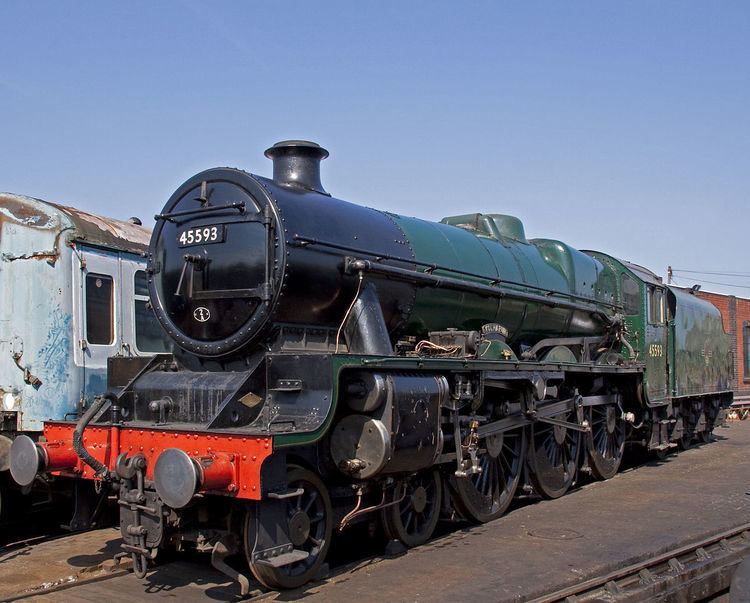Power type Steam Build date 1934–1936 | Total produced 191 | |
 | ||
Order number LMS Lot nos. 97, 112, 113, 118, 121, 129 | ||
The London Midland and Scottish Railway (LMS) Jubilee Class is a class of steam locomotive designed for main line passenger work. 191 locomotives were built between 1934 and 1936. They were built concurrently with the LMS Stanier Class 5 4-6-0.
Contents
History
The last five locomotives of Henry Fowler's Patriot class on order, 5552 to 5557, were built with William Stanier’s taper boiler and so became the first of the Jubilee class. 113 locomotives were ordered straight from the drawing board. They were initially a disappointment; their moderate degree of superheating often left them short of steam. Changes to the blastpipe and chimney dimensions helped to transform them.
On 29 April 1935 no. 5552, the first of the class, permanently swapped identities with no. 5642 which had been named Silver Jubilee on 19 April 1935 in recognition of the Silver Jubilee of King George V on 6 May of that year. This change gave the name to the rest of the class, see LMS Jubilee Class 5552 Silver Jubilee. Earlier on (from summer 1934), they had been known as the "Red Staniers" (because of the crimson livery), to distinguish them from the "Black Staniers" (the LMS Stanier Black Five class).
They are often associated with the Midland Division, i.e. the lines inherited from the former Midland Railway. This is because until the late 1950s, it was rare for any 7P locomotives to work south of Leeds. Until then, Jubilees were the largest express engine normally found on the lines running out of St Pancras or radiating from Derby. They could nevertheless be found on main lines throughout the former LMS system.
The power classification was 5XP, in common with the earlier Patriot class. In January 1951, the classification was revised to 6P; this was revised again to 6P5F in November 1955, but the latter change was not applied to the locomotives' cabsides, which continued to show 6P. The two rebuilt locomotives (nos. 5735/6) were reclassified 6P in July 1943, being revised to 7P in 1951.
In 1961 four members of the class were fitted with a double chimney as a final experiment by BR, the double chimney did improve the power of the locos and also improved the coal consumption. Only one member of the double chimneyed Jubilees has survived into preservation and this is 45596 Bahamas.
Construction
Although built over only a three-year period the class had many variations due to improvements being made as they were built. The major differences were:
Withdrawal
One locomotive was scrapped in 1952 due to accident damage. The remaining locomotives were withdrawn between 1960 and 1967.
Accidents and incidents
Preservation
Four Jubilees have been preserved with two of them 45593 & 45596 being purchased directly from BR for preservation, the other two being rescued from Barry Scrapyard. All four members of the class have operated in preservation and all have operated on the mainline. Presently two members of the class 45690 Leander & 45699 Galatea are operational on the mainline (Galatea required one new set of driving wheels after one of hers was cut up in Barry when she was derailed, she returned to service in 2013).
45596 Bahamas has been undergoing an overhaul at Tyseley Loco Works since 2013 and is being done to full Network Rail standards and it is planned for her to return to service near the end of 2017 with a mainline debut in 2018. 45593 Kolhapur meanwhile is stored inside the shed at Tyseley Loco Works awaiting it's turn in the overhaul queue.
A large number of parts were taken from sister engine 5562 Alberta before she was scrapped and most parts exist on preserved sister engine Galatea.
